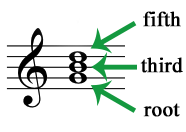Chords
Chords are the basic units of harmony. A chord is an organized group of three or more simultaneous pitches. Any combination of pitches sounded simultaneously can be considered harmony, but chords are organized according to the intervals they contain and by the way they behave in relation to each other.
Triads
A triad is the most basic chord. A triad consists of three pitches (no more, no less) and is built by stacking major and/or minor thirds. The bottom note of a basic triad is known as the root. The middle note is the third because it is a 3rd above the root, and the top one is the fifth because it is a 5th above the root.

The qualities of the thirds (major or minor) used to build a triad determine the quality of the chord itself. The interval between the lowest note and the highest note of a major or minor triad is a perfect fifth, but the inner intervals differ. A major triad has a major third on the bottom and a minor third on the top, whereas a minor triad has a minor third on the bottom and a major third on the top. A triad that consists of two minor thirds is a diminished triad, and the interval between the lowest and highest notes is a diminished fifth. A triad that uses two major thirds is an augmented triad, and the interval between the lowest and highest notes of this triad is an augmented fifth.
| Major Triad | Minor Triad | Diminished Triad | Augmented Triad | |||||||
| perfect fifth | minor third | perfect fifth | major third | diminished fifth | minor third | augmented fifth | major third | |||
| major third | minor third | minor third | major third | |||||||
Triad Qualities
Arpeggios
When the notes of a chord are played in sequence rather than simultaneously, we call this an arpeggio. Arpeggios are used in place of block chords (where all pitches are played simultaneously) in order to add rhythmic movement in a place that is harmonically static. Composers often give arpeggios to instruments that are not able to sustain pitches for a long period of time (examples: harpsichord, harp, guitar) because the pattern they create allows the same note to be sounded over and over again, giving the impression of a sustained pitch. This illusion of sustain allows the sequential pitches in arpeggios to imply a simultaneous chord.

